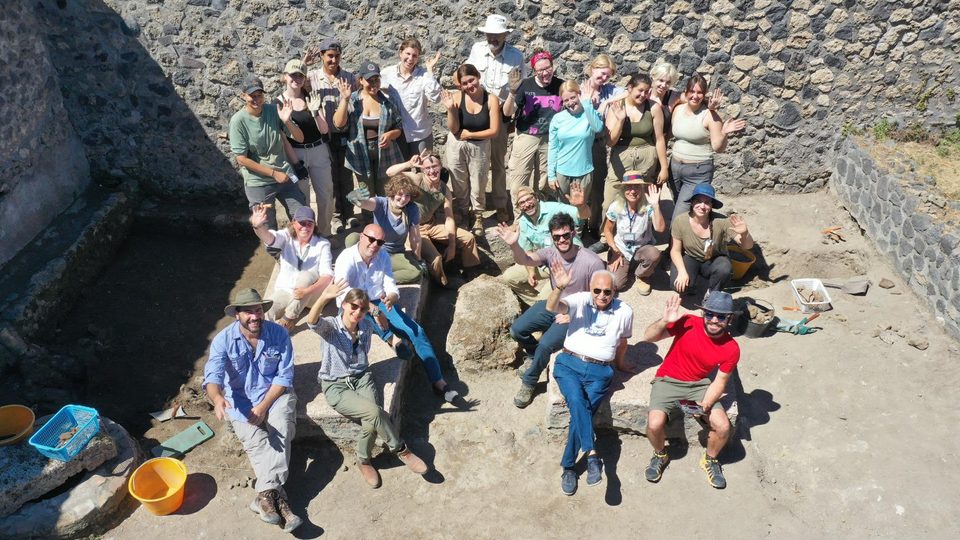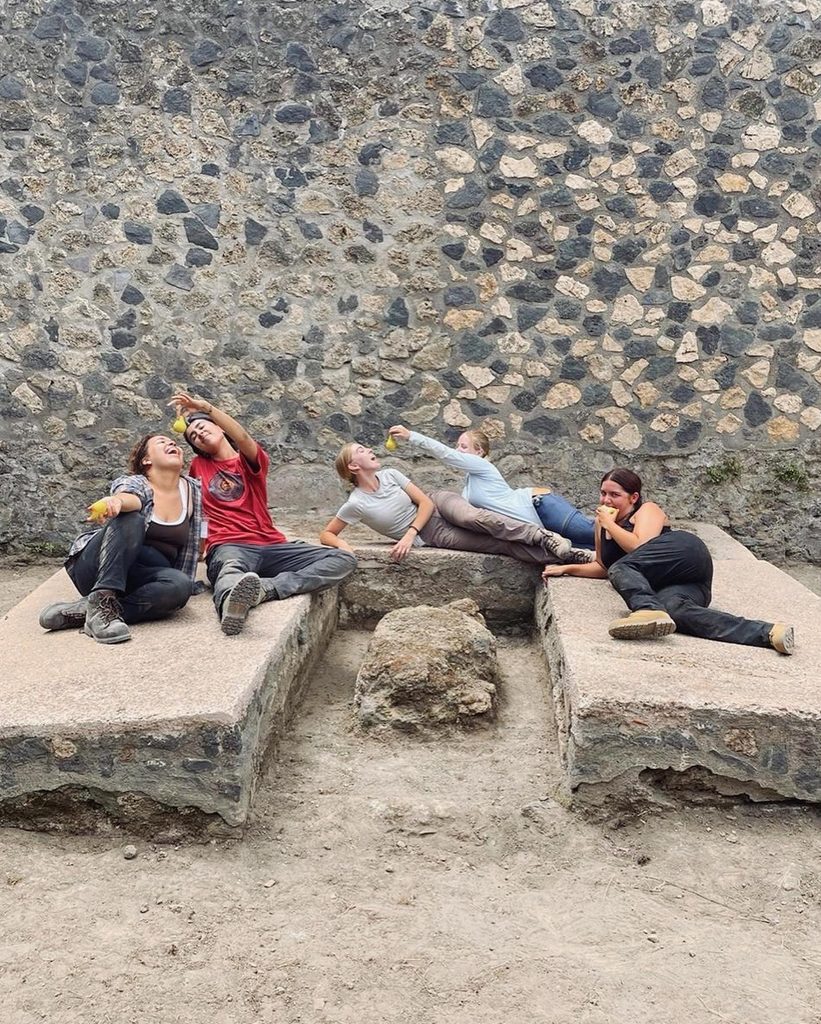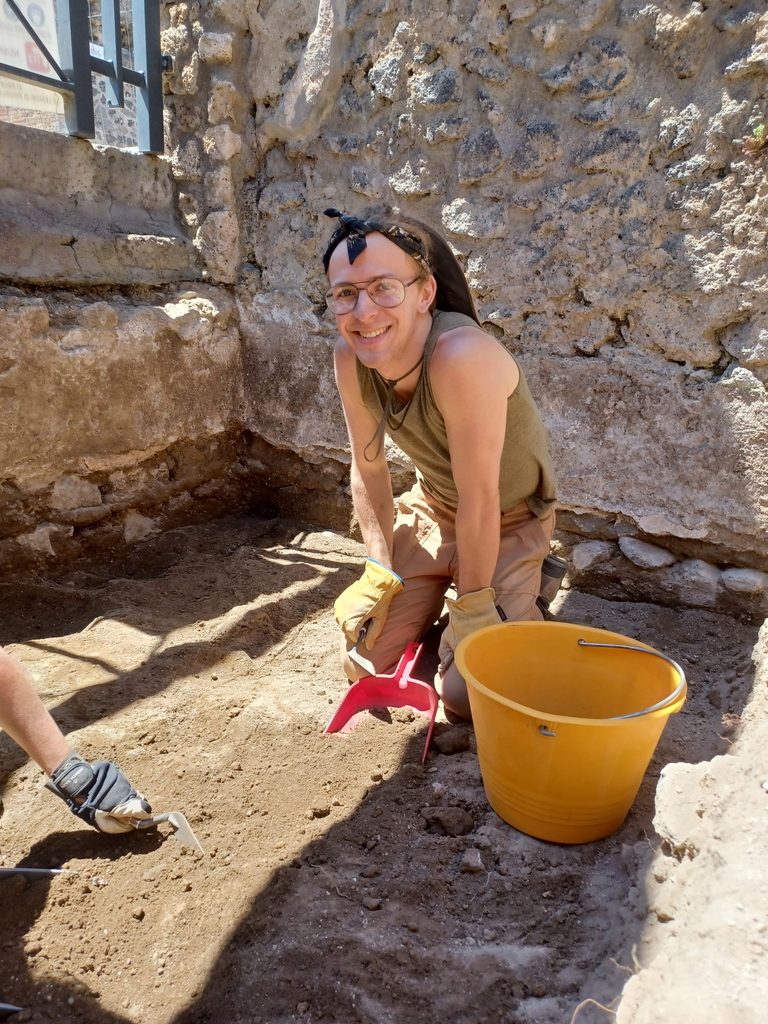Carls unearth a story of the past in Pompeii
Professor Jordan Rogers, Sidra Michael ’23 and Sam Zimmerman ’24 studied what part of the city was like before Mount Vesuvius’ infamous eruption.

The Student Research Partnership (SRP) program from Carleton’s Humanities Center creates opportunities for students and faculty to work closely and collaboratively on research for their mutual benefit. From translating texts on campus to doing anthropological fieldwork abroad, the kinds of research Carls have helped faculty with this summer span a broad spectrum.
Jordan Rogers, visiting assistant professor of classics and an SRP host for this summer, brought Sidra Michael ’23 and Sam Zimmerman ’24 along with him, some of his colleagues and their students to the ancient city of Pompeii in Italy for help with archaeological field research.

Rogers summarized the group’s purpose as “trying to figure out what happened before the eruption” of Mount Vesuvius in 79 C.E. Their goal was to better understand the urban development of the neighborhood in the southeast corner of Pompeii; its relationship with the city’s suburban development along the nearby Sarno river; and the architectural, economic and cultural changes experienced by the inhabitants in the centuries preceding the volcanic eruption.
In their day-to-day archaeological work, the group—which consisted of students and supervisors from Mount Holyoke College, Princeton University, Tulane University and University of Oxford as well as Carleton—split into three, excavating in three different trenches in three different areas of an insula, a city block with properties sharing walls and often a facade. Michael and Zimmerman were split up for this work, allowing them to interact with people from the other colleges and universities.
“We have specialists from all over the place, all with different expertise,” said Rogers, “which is really great, because the students get to work with people other than just me. I only know a certain number of things, so this way, the students get to mix and mingle and learn from each other as well as the other specialists on the project… Allison Emmerson, associate professor of classics at Tulane, is the director of the project, and Mark Robinson, a professor at Oxford, is a bioarchaeologist and in charge of the building’s garden area. You can show him any soil and he can tell you all the little pieces in there, including seed pods and fish scales, which is so impressive. Sidra has been working a lot in the garden with him.”

The garden, which Michael identified as “peristyle,” is in the middle of the insula the group worked in.
“There’s a triclinium [a formal Roman dining room], what is potentially an altar, a really degraded table that would have had a marble slab on it for dining, a cistern and a really exciting drain,” Michael said. “We’ve also found several lapilli holes [created when pumice ejected from a volcano falls into holes left from decomposed biological material], some of which have roots, so they were probably for plants. Some holes are pointed towards the bottom, so they were probably for stakes to train climbing plants or for a pergola to go over the triclinium.”
Regardless of where in the insula the students worked, excavation was the name of the game.
“The basic task of archaeology is excavating, which means removing soil and then sifting through it to find its components,” explained Zimmerman. “That’s what we’re doing all day every day, for the most part. We also excavate stratigraphically, meaning we try to dig in sections, taking out only soil from the same phase. If soil is from the same phase, that means it looks similar, has the same kind of materials in it and was all put there at more or less the same time. When we excavate, we dig all of that out, clean it off and then take out the next layer of soil. When we’re sifting, we find exciting things like pieces of pottery and plaster, pieces of charcoal, bits of bone—”
“Teeth,” Michael interjected.
“Yeah, teeth are great,” Zimmerman agreed. “They’re shiny when you pull them out of the ground, which is really cool.”
When the students weren’t excavating, they washed their finds and sorted them using different methods.
“Often we do flotation,” said Michael, “which is when we sift through dirt or soil samples using water to get to all the very small things that either float, hence the name, or do not float. What doesn’t float is called heavy fraction. Then you sort through all the sediment to pick out microscopic things like fish bones or tiny pieces of gemstone, if you’re lucky. We have not found any gemstones but everyone keeps talking about it as if we might!”

What could be better than gemstones? Worms, apparently!
“There are so many worms,” Michael said. “I love the worms. That’s my favorite part actually, the worms.”
“That wasn’t a joke, by the way,” Zimmerman made sure to clarify.
“Yeah, we love the invertebrates,” Michael nodded.
Aside from all their fascinating finds, Michael appreciated the unique nature of her experience in Pompeii.
“I really enjoy meeting new people and doing new things,” she said. “Before this trip, I was not an archeology person per se, but I am now, and that’s been exciting and fun. This is a very cool thing to be able to say I’ve done and I’ve been having a good time doing it.”
Rogers, ever the dedicated professor, was all about the intellectual stimulation.
“You might expect this to be my least favorite thing, but really it’s my favorite,” he said. “Every day, we think we know what we have, right? We come across a new stratigraphic unit, interpret it and think, ‘Oh we’ve got it, it all makes sense.’ And then the next day, we find something new and it completely upends what we thought was going on. Or, even if it’s not completely, we often have to reassess and rethink things on the fly. That’s so exciting, because every time you go out to dig in the morning, you know you’re going to find something that will change the way you’re telling the story of the past, essentially. I love that. It’s such a fun part of the excavation process.”
The experience of learning and growing and changing their minds will certainly help Michael and Zimmerman during the rest of their liberal arts education, even if they weren’t continuing with archaeology—which they are both very much planning on doing.

“I’m an art history major,” Michael said. “I’d taken some classics courses but no archaeology, especially in relation to my major. But this trip has made me feel like there are more options for my future, because I’ve really enjoyed doing this work. That’s exciting and I will definitely be taking more classics courses in the time I have left at Carleton.”
“I just declared a classics major,” Zimmerman added, “which I chose more because I like classical languages. Prior to this trip, I’d never taken an archaeology course. Now, though, I’m taking a classical archaeology class while abroad in the fall and I’m getting more and more excited for Victoria Austen’s Pompeii class in the winter, which originally, I wasn’t even considering. This project has nudged me more towards the archaeology side of classics and that’s very exciting.”
Faculty interested in applying for next year’s Student Research Partnerships should direct any questions to Clara Hardy. Students interested in participating should inform their professors whose research they find intriguing.
Erica Helgerud ’20 is the news and social media manager for Carleton College.